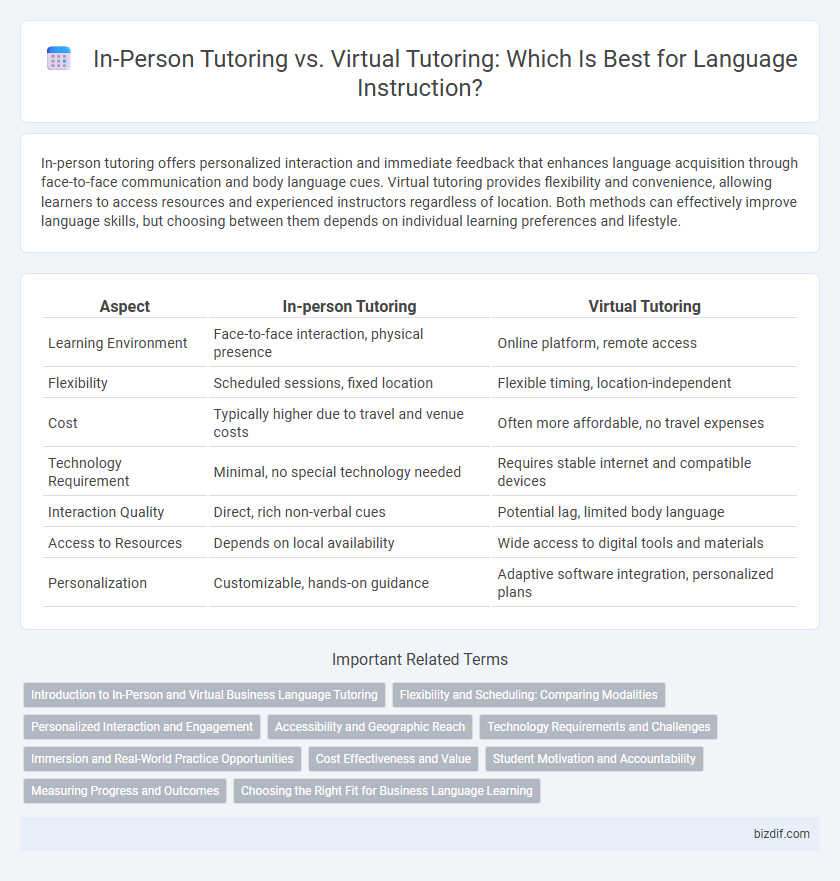In-person tutoring offers personalized interaction and immediate feedback that enhances language acquisition through face-to-face communication and body language cues. Virtual tutoring provides flexibility and convenience, allowing learners to access resources and experienced instructors regardless of location. Both methods can effectively improve language skills, but choosing between them depends on individual learning preferences and lifestyle.
Table of Comparison
| Aspect | In-person Tutoring | Virtual Tutoring |
|---|---|---|
| Learning Environment | Face-to-face interaction, physical presence | Online platform, remote access |
| Flexibility | Scheduled sessions, fixed location | Flexible timing, location-independent |
| Cost | Typically higher due to travel and venue costs | Often more affordable, no travel expenses |
| Technology Requirement | Minimal, no special technology needed | Requires stable internet and compatible devices |
| Interaction Quality | Direct, rich non-verbal cues | Potential lag, limited body language |
| Access to Resources | Depends on local availability | Wide access to digital tools and materials |
| Personalization | Customizable, hands-on guidance | Adaptive software integration, personalized plans |
Introduction to In-Person and Virtual Business Language Tutoring
In-person business language tutoring offers direct interaction and immediate feedback, fostering a dynamic learning environment that enhances communication skills and cultural understanding. Virtual business language tutoring provides flexible scheduling and access to native speakers from around the world, utilizing digital tools to simulate immersive experiences. Both methods cater to professional language acquisition but differ in convenience, personalization, and engagement levels.
Flexibility and Scheduling: Comparing Modalities
In-person tutoring offers structured scheduling with fixed appointments, which can benefit students who thrive on routine and direct accountability. Virtual tutoring provides greater flexibility, allowing sessions to be arranged across different time zones and adapted to diverse schedules, facilitating learning from any location. Both modalities accommodate various learning preferences, but virtual options excel in convenience and accessibility for busy or remote learners.
Personalized Interaction and Engagement
In-person tutoring offers personalized interaction through direct face-to-face communication, enabling tutors to adapt lesson plans instantly based on immediate feedback and non-verbal cues. Virtual tutoring leverages digital tools like interactive whiteboards and real-time chats to maintain engagement but may face challenges in replicating the natural rapport found in physical settings. Both methods prioritize individualized attention, though in-person sessions often provide deeper emotional connection and heightened student motivation.
Accessibility and Geographic Reach
In-person tutoring offers localized, face-to-face interaction that can enhance personalized learning but is limited by geographic constraints and scheduling availability. Virtual tutoring removes these barriers, providing accessibility to students regardless of location, enabling flexible session timing, and connecting learners to a broader range of language experts. The expanded geographic reach of virtual platforms significantly increases educational opportunities, especially for students in remote or underserved areas.
Technology Requirements and Challenges
In-person tutoring requires minimal technology, often just basic writing tools and printed materials, reducing technical issues and distractions. Virtual tutoring depends heavily on reliable internet connections, compatible devices, and software platforms, posing challenges like connectivity disruptions and digital literacy barriers. These technology requirements directly impact the effectiveness and accessibility of language instruction in each format.
Immersion and Real-World Practice Opportunities
In-person tutoring offers immersive language learning experiences by enabling real-time, face-to-face interactions that facilitate natural conversation practice and immediate feedback. Virtual tutoring, while flexible and accessible, often lacks the sensory and environmental cues essential for full immersion, potentially limiting exposure to authentic cultural contexts. Real-world practice opportunities are more readily integrated in physical settings through local community engagement, enhancing language retention and practical usage.
Cost Effectiveness and Value
In-person tutoring often involves higher costs due to travel, facility fees, and limited scheduling flexibility, whereas virtual tutoring offers more affordable session rates and eliminates commuting expenses. Virtual platforms provide access to a broader range of tutors, enhancing value through personalized instruction tailored to individual learning styles and needs. While in-person tutoring may offer richer sensory engagement, virtual tutoring maximizes cost-effectiveness and instructional accessibility.
Student Motivation and Accountability
In-person tutoring fosters higher student motivation through direct personal interaction and immediate feedback, creating a structured learning environment that enhances accountability. Virtual tutoring leverages digital tools to track progress and set reminders, but may require greater self-discipline from students due to physical separation from the tutor. Both methods benefit from clear goal-setting and consistent communication to maintain student engagement and responsibility.
Measuring Progress and Outcomes
In-person tutoring allows for immediate, personalized feedback through direct observation of student performance, facilitating real-time adjustments in teaching methods. Virtual tutoring leverages digital tools and analytics to track progress comprehensively, offering detailed reports on assessment results and engagement metrics. Both methods benefit from regular evaluations, but virtual platforms often provide more accessible data visualization for monitoring long-term learning outcomes.
Choosing the Right Fit for Business Language Learning
In-person tutoring for business language learning offers direct interaction and immediate feedback, fostering a personalized and immersive environment essential for mastering industry-specific terminology. Virtual tutoring provides flexibility and access to a diverse range of expert instructors worldwide, ideal for busy professionals balancing schedules. Selecting the right fit depends on business goals, learner preferences, and the need for real-time engagement versus convenience and variety in language instruction.
In-person Tutoring vs Virtual Tutoring Infographic

 bizdif.com
bizdif.com